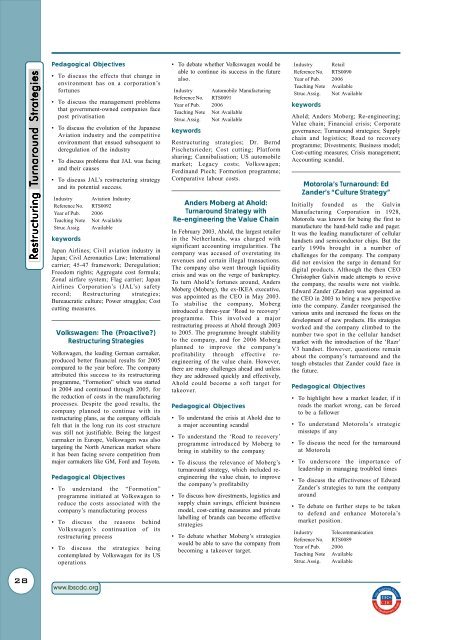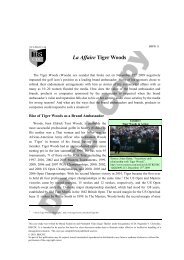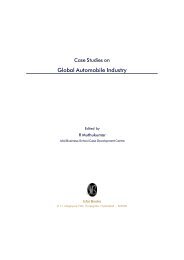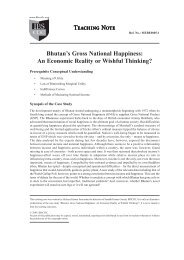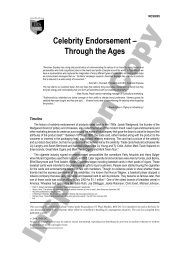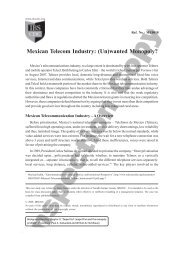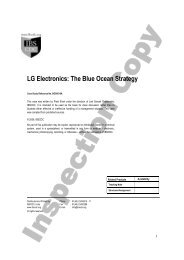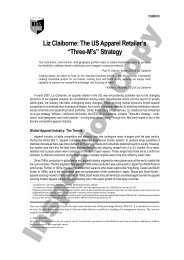List of Case Studies on Strategy - Case Catalogue IV
List of Case Studies on Strategy - Case Catalogue IV
List of Case Studies on Strategy - Case Catalogue IV
Create successful ePaper yourself
Turn your PDF publications into a flip-book with our unique Google optimized e-Paper software.
28<br />
Restructuring estructuring T TTurnaround<br />
T urnaround Strategies<br />
Strategies<br />
Pedagogical Objectives<br />
• To discuss the effects that change in<br />
envir<strong>on</strong>ment has <strong>on</strong> a corporati<strong>on</strong>’s<br />
fortunes<br />
• To discuss the management problems<br />
that government-owned companies face<br />
post privatisati<strong>on</strong><br />
• To discuss the evoluti<strong>on</strong> <str<strong>on</strong>g>of</str<strong>on</strong>g> the Japanese<br />
Aviati<strong>on</strong> industry and the competitive<br />
envir<strong>on</strong>ment that ensued subsequent to<br />
deregulati<strong>on</strong> <str<strong>on</strong>g>of</str<strong>on</strong>g> the industry<br />
• To discuss problems that JAL was facing<br />
and their causes<br />
• To discuss JAL’s restructuring strategy<br />
and its potential success.<br />
Industry Aviati<strong>on</strong> Industry<br />
Reference No. RTS0092<br />
Year <str<strong>on</strong>g>of</str<strong>on</strong>g> Pub. 2006<br />
Teaching Note Not Available<br />
Struc.Assig. Available<br />
keywords<br />
Japan Airlines; Civil aviati<strong>on</strong> industry in<br />
Japan; Civil Aer<strong>on</strong>autics Law; Internati<strong>on</strong>al<br />
carrier; 45-47 framework; Deregulati<strong>on</strong>;<br />
Freedom rights; Aggregate cost formula;<br />
Z<strong>on</strong>al airfare system; Flag carrier; Japan<br />
Airlines Corporati<strong>on</strong>’s (JAL’s) safety<br />
record; Restructuring strategies;<br />
Bureaucratic culture; Power struggles; Cost<br />
cutting measures.<br />
Volkswagen: The (Proactive?)<br />
Restructuring Strategies<br />
Volkswagen, the leading German carmaker,<br />
produced better financial results for 2005<br />
compared to the year before. The company<br />
attributed this success to its restructuring<br />
programme, “Formoti<strong>on</strong>” which was started<br />
in 2004 and c<strong>on</strong>tinued through 2005, for<br />
the reducti<strong>on</strong> <str<strong>on</strong>g>of</str<strong>on</strong>g> costs in the manufacturing<br />
processes. Despite the good results, the<br />
company planned to c<strong>on</strong>tinue with its<br />
restructuring plans, as the company <str<strong>on</strong>g>of</str<strong>on</strong>g>ficials<br />
felt that in the l<strong>on</strong>g run its cost structure<br />
was still not justifiable. Being the largest<br />
carmaker in Europe, Volkswagen was also<br />
targeting the North American market where<br />
it has been facing severe competiti<strong>on</strong> from<br />
major carmakers like GM, Ford and Toyota.<br />
Pedagogical Objectives<br />
• To understand the “Formoti<strong>on</strong>”<br />
programme initiated at Volkswagen to<br />
reduce the costs associated with the<br />
company’s manufacturing process<br />
• To discuss the reas<strong>on</strong>s behind<br />
Volkswagen’s c<strong>on</strong>tinuati<strong>on</strong> <str<strong>on</strong>g>of</str<strong>on</strong>g> its<br />
restructuring process<br />
• To discuss the strategies being<br />
c<strong>on</strong>templated by Volkswagen for its US<br />
operati<strong>on</strong>s<br />
www.ibscdc.org<br />
• To debate whether Volkswagen would be<br />
able to c<strong>on</strong>tinue its success in the future<br />
also.<br />
Industry Automobile Manufacturing<br />
Reference No. RTS0091<br />
Year <str<strong>on</strong>g>of</str<strong>on</strong>g> Pub. 2006<br />
Teaching Note Not Available<br />
Struc.Assig. Not Available<br />
keywords<br />
Restructuring strategies; Dr. Bernd<br />
Pischetsrieder; Cost cutting; Platform<br />
sharing; Cannibalisati<strong>on</strong>; US automobile<br />
market; Legacy costs; Volkswagen;<br />
Ferdinand Piech; Formoti<strong>on</strong> programme;<br />
Comparative labour costs.<br />
Anders Moberg at Ahold:<br />
Turnaround <strong>Strategy</strong> with<br />
Re-engineering the Value Chain<br />
In February 2003, Ahold, the largest retailer<br />
in the Netherlands, was charged with<br />
significant accounting irregularities. The<br />
company was accused <str<strong>on</strong>g>of</str<strong>on</strong>g> overstating its<br />
revenues and certain illegal transacti<strong>on</strong>s.<br />
The company also went through liquidity<br />
crisis and was <strong>on</strong> the verge <str<strong>on</strong>g>of</str<strong>on</strong>g> bankruptcy.<br />
To turn Ahold’s fortunes around, Anders<br />
Moberg (Moberg), the ex-IKEA executive,<br />
was appointed as the CEO in May 2003.<br />
To stabilise the company, Moberg<br />
introduced a three-year ‘Road to recovery’<br />
programme. This involved a major<br />
restructuring process at Ahold through 2003<br />
to 2005. The programme brought stability<br />
to the company, and for 2006 Moberg<br />
planned to improve the company’s<br />
pr<str<strong>on</strong>g>of</str<strong>on</strong>g>itability through effective reengineering<br />
<str<strong>on</strong>g>of</str<strong>on</strong>g> the value chain. However,<br />
there are many challenges ahead and unless<br />
they are addressed quickly and effectively,<br />
Ahold could become a s<str<strong>on</strong>g>of</str<strong>on</strong>g>t target for<br />
takeover.<br />
Pedagogical Objectives<br />
• To understand the crisis at Ahold due to<br />
a major accounting scandal<br />
• To understand the ‘Road to recovery’<br />
programme introduced by Moberg to<br />
bring in stability to the company<br />
• To discuss the relevance <str<strong>on</strong>g>of</str<strong>on</strong>g> Moberg’s<br />
turnaround strategy, which included reengineering<br />
the value chain, to improve<br />
the company’s pr<str<strong>on</strong>g>of</str<strong>on</strong>g>itabilty<br />
• To discuss how divestments, logistics and<br />
supply chain savings, efficient business<br />
model, cost-cutting measures and private<br />
labelling <str<strong>on</strong>g>of</str<strong>on</strong>g> brands can become effective<br />
strategies<br />
• To debate whether Moberg’s strategies<br />
would be able to save the company from<br />
becoming a takeover target.<br />
Industry Retail<br />
Reference No. RTS0090<br />
Year <str<strong>on</strong>g>of</str<strong>on</strong>g> Pub. 2006<br />
Teaching Note Available<br />
Struc.Assig. Not Available<br />
keywords<br />
Ahold; Anders Moberg; Re-engineering;<br />
Value chain; Financial crisis; Corporate<br />
governance; Turnaround strategies; Supply<br />
chain and logistics; Road to recovery<br />
programme; Divestments; Business model;<br />
Cost-cutting measures; Crisis management;<br />
Accounting scandal.<br />
Motorola’s Turnaround: Ed<br />
Zander’s “Culture <strong>Strategy</strong>”<br />
Initially founded as the Galvin<br />
Manufacturing Corporati<strong>on</strong> in 1928,<br />
Motorola was known for being the first to<br />
manufacture the hand-held radio and pager.<br />
It was the leading manufacturer <str<strong>on</strong>g>of</str<strong>on</strong>g> cellular<br />
handsets and semic<strong>on</strong>ductor chips. But the<br />
early 1990s brought in a number <str<strong>on</strong>g>of</str<strong>on</strong>g><br />
challenges for the company. The company<br />
did not envisi<strong>on</strong> the surge in demand for<br />
digital products. Although the then CEO<br />
Christopher Galvin made attempts to revive<br />
the company, the results were not visible.<br />
Edward Zander (Zander) was appointed as<br />
the CEO in 2003 to bring a new perspective<br />
into the company. Zander reorganised the<br />
various units and increased the focus <strong>on</strong> the<br />
development <str<strong>on</strong>g>of</str<strong>on</strong>g> new products. His strategies<br />
worked and the company climbed to the<br />
number two spot in the cellular handset<br />
market with the introducti<strong>on</strong> <str<strong>on</strong>g>of</str<strong>on</strong>g> the ‘Razr’<br />
V3 handset. However, questi<strong>on</strong>s remain<br />
about the company’s turnaround and the<br />
tough obstacles that Zander could face in<br />
the future.<br />
Pedagogical Objectives<br />
• To highlight how a market leader, if it<br />
reads the market wr<strong>on</strong>g, can be forced<br />
to be a follower<br />
• To understand Motorola’s strategic<br />
missteps if any<br />
• To discuss the need for the turnaround<br />
at Motorola<br />
• To underscore the importance <str<strong>on</strong>g>of</str<strong>on</strong>g><br />
leadership in managing troubled times<br />
• To discuss the effectiveness <str<strong>on</strong>g>of</str<strong>on</strong>g> Edward<br />
Zander’s strategies to turn the company<br />
around<br />
• To debate <strong>on</strong> further steps to be taken<br />
to defend and enhance Motorola’s<br />
market positi<strong>on</strong>.<br />
Industry Telecommunicati<strong>on</strong><br />
Reference No. RTS0089<br />
Year <str<strong>on</strong>g>of</str<strong>on</strong>g> Pub. 2006<br />
Teaching Note Available<br />
Struc.Assig. Available


